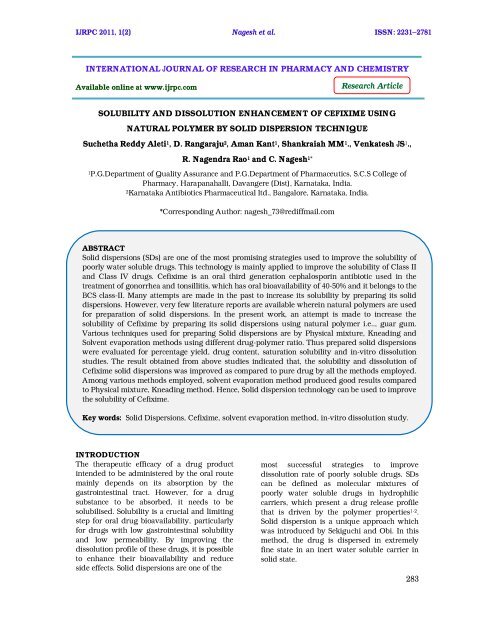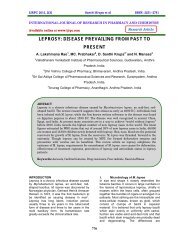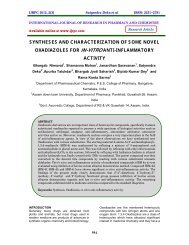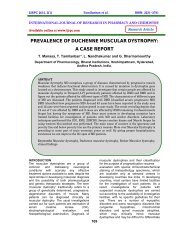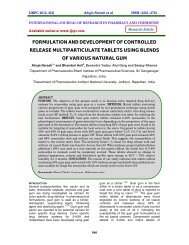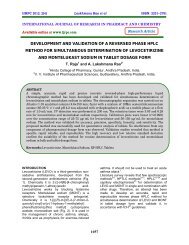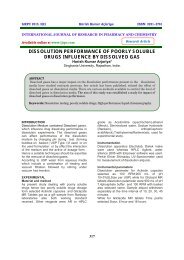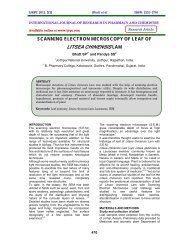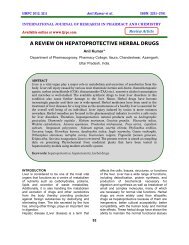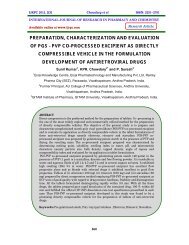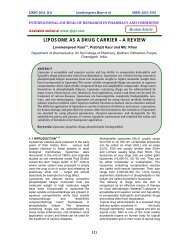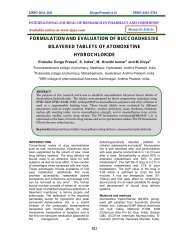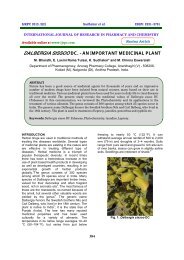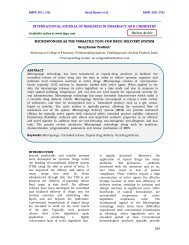Solubility and dissolution enhancement of cefixime using - ijrpc
Solubility and dissolution enhancement of cefixime using - ijrpc
Solubility and dissolution enhancement of cefixime using - ijrpc
Create successful ePaper yourself
Turn your PDF publications into a flip-book with our unique Google optimized e-Paper software.
IJRPC 2011, 1(2) Nagesh et al. ISSN: 2231�2781<br />
INTERNATIONAL JOURNAL OF RESEARCH IN PHARMACY AND CHEMISTRY<br />
Available online at www.<strong>ijrpc</strong>.com<br />
SOLUBILITY AND DISSOLUTION ENHANCEMENT OF CEFIXIME USING<br />
NATURAL POLYMER BY SOLID DISPERSION TECHNIQUE<br />
Suchetha Reddy Aleti 1, D. Rangaraju 2, Aman Kant 1, Shankraiah MM 1., Venkatesh JS 1.,<br />
R. Nagendra Rao 1 <strong>and</strong> C. Nagesh 1*<br />
1P.G.Department <strong>of</strong> Quality Assurance <strong>and</strong> P.G.Department <strong>of</strong> Pharmaceutics, S.C.S College <strong>of</strong><br />
Pharmacy, Harapanahalli, Davangere (Dist), Karnataka, India.<br />
2 Karnataka Antibiotics Pharmaceutical ltd., Bangalore, Karnataka, India.<br />
INTRODUCTION<br />
The therapeutic efficacy <strong>of</strong> a drug product<br />
intended to be administered by the oral route<br />
mainly depends on its absorption by the<br />
gastrointestinal tract. However, for a drug<br />
substance to be absorbed, it needs to be<br />
solubilised. <strong>Solubility</strong> is a crucial <strong>and</strong> limiting<br />
step for oral drug bioavailability, particularly<br />
for drugs with low gastrointestinal solubility<br />
<strong>and</strong> low permeability. By improving the<br />
<strong>dissolution</strong> pr<strong>of</strong>ile <strong>of</strong> these drugs, it is possible<br />
to enhance their bioavailability <strong>and</strong> reduce<br />
side effects. Solid dispersions are one <strong>of</strong> the<br />
*Corresponding Author: nagesh_73@rediffmail.com<br />
Research Article<br />
ABSTRACT<br />
Solid dispersions (SDs) are one <strong>of</strong> the most promising strategies used to improve the solubility <strong>of</strong><br />
poorly water soluble drugs. This technology is mainly applied to improve the solubility <strong>of</strong> Class II<br />
<strong>and</strong> Class IV drugs. Cefixime is an oral third generation cephalosporin antibiotic used in the<br />
treatment <strong>of</strong> gonorrhea <strong>and</strong> tonsillitis, which has oral bioavailability <strong>of</strong> 40-50% <strong>and</strong> it belongs to the<br />
BCS class-II. Many attempts are made in the past to increase its solubility by preparing its solid<br />
dispersions. However, very few literature reports are available wherein natural polymers are used<br />
for preparation <strong>of</strong> solid dispersions. In the present work, an attempt is made to increase the<br />
solubility <strong>of</strong> Cefixime by preparing its solid dispersions <strong>using</strong> natural polymer i.e.., guar gum.<br />
Various techniques used for preparing Solid dispersions are by Physical mixture, Kneading <strong>and</strong><br />
Solvent evaporation methods <strong>using</strong> different drug-polymer ratio. Thus prepared solid dispersions<br />
were evaluated for percentage yield, drug content, saturation solubility <strong>and</strong> in-vitro <strong>dissolution</strong><br />
studies. The result obtained from above studies indicated that, the solubility <strong>and</strong> <strong>dissolution</strong> <strong>of</strong><br />
Cefixime solid dispersions was improved as compared to pure drug by all the methods employed.<br />
Among various methods employed, solvent evaporation method produced good results compared<br />
to Physical mixture, Kneading method. Hence, Solid dispersion technology can be used to improve<br />
the solubility <strong>of</strong> Cefixime.<br />
Key words: Solid Dispersions, Cefixime, solvent evaporation method, in-vitro <strong>dissolution</strong> study.<br />
most successful strategies to improve<br />
<strong>dissolution</strong> rate <strong>of</strong> poorly soluble drugs. SDs<br />
can be defined as molecular mixtures <strong>of</strong><br />
poorly water soluble drugs in hydrophilic<br />
carriers, which present a drug release pr<strong>of</strong>ile<br />
that is driven by the polymer properties 1-2 .<br />
Solid dispersion is a unique approach which<br />
was introduced by Sekiguchi <strong>and</strong> Obi. In this<br />
method, the drug is dispersed in extremely<br />
fine state in an inert water soluble carrier in<br />
solid state.<br />
283
IJRPC 2011, 1(2) Nagesh et al. ISSN: 2231�2781<br />
Number <strong>of</strong> insoluble drugs has shown to<br />
improve their <strong>dissolution</strong> character when<br />
converted to solid dispersion. Solid dispersion<br />
technology is a well known process used to<br />
increase the <strong>dissolution</strong> kinetics <strong>and</strong> oral<br />
absorption <strong>of</strong> poorly water soluble drugs<br />
<strong>using</strong> water soluble inert carriers 3. A number<br />
<strong>of</strong> freely water soluble materials such as citric<br />
acid, succinic acid, bile acids, sterols <strong>and</strong><br />
related compounds <strong>and</strong> polymers like<br />
polyvinyl pyrrolidone <strong>and</strong> poly ethylene<br />
glycols are used as carrier for solid<br />
dispersions. By this approach the <strong>dissolution</strong><br />
rate <strong>and</strong> bioavaibility <strong>of</strong> poorly soluble drugs<br />
can be increased 4. The use <strong>of</strong> hydrophilic<br />
polymers as carriers for the <strong>dissolution</strong><br />
<strong>enhancement</strong> <strong>of</strong> poorly water-soluble drug is<br />
increasing.Various hydrophilic carriers such as<br />
natural polymers viz. guar gum has been<br />
investigated for improvement <strong>of</strong> <strong>dissolution</strong><br />
characteristics <strong>and</strong> bioavailability <strong>of</strong> poorly<br />
aqueous soluble drugs 5.<br />
Cefixime is an oral third generation<br />
cephalosporin antibiotic which is used in the<br />
treatment <strong>of</strong> gonorrhea, tonsillitis <strong>and</strong><br />
pharyngitis 6-7. Cefixime is employed in the<br />
treatment <strong>of</strong> a variety <strong>of</strong> respiratory tract<br />
infections <strong>and</strong> otitis media 8 . However, the low<br />
aqueous solubility <strong>and</strong> poor <strong>dissolution</strong> <strong>of</strong> this<br />
drug in gastric fluid affects its rate <strong>of</strong><br />
absorption, resulting in a low <strong>and</strong> variable oral<br />
bioavailability. Hence, the present study was<br />
aimed to increase the solubility <strong>and</strong><br />
bioavailability <strong>of</strong> Cefixime <strong>using</strong> natural<br />
polymer i.e. gaur gum. Cefixime solid<br />
dispersions were prepared by different<br />
techniques viz. physical mixture, solvent<br />
evaporation method <strong>and</strong> kneading method.<br />
EXPERIMENTAL<br />
Materials<br />
Cefixime was received as gift sample form the<br />
Karnataka antibiotics pharmaceutical Limited,<br />
Bangalore <strong>and</strong> all chemicals used are<br />
purchased from the S.D Fine chemicals,<br />
Mumbai <strong>of</strong> analytical grade.<br />
Methods<br />
Preparation <strong>of</strong> Physical Mixtures (PM) <strong>and</strong><br />
Solid dispersions<br />
PM were prepared by taking Cefixime <strong>and</strong><br />
guar gum in the glass mortar <strong>and</strong> mixed by<br />
light trituration for 3 min. PMs <strong>of</strong> different<br />
proportions <strong>of</strong> Cefixime <strong>and</strong> Guar Gum were<br />
prepared i.e.. 1:1, 1:2, 1:3. The mixture was<br />
sieved <strong>and</strong> the powder fraction corresponding<br />
to mesh size less than 30 was collected for<br />
further investigation. 9-10<br />
Kneading method<br />
Drug <strong>and</strong> polymer was mixed with the small<br />
amount <strong>of</strong> the solvent i.e. water to form a thick<br />
paste by kneading <strong>and</strong> hence it was dried at<br />
45 ºC in an oven. The mass was passed through<br />
the sieve no. 30 <strong>and</strong> stored in the dessicator. 11<br />
Solvent evaporation method<br />
The drug <strong>and</strong> the polymer were dissolved in<br />
sufficient volume <strong>of</strong> dichloromethane with<br />
continuous stirring. The solvent was then<br />
completely evaporated at room temperature<br />
with continuous stirring to obtain dry<br />
granules. The resulting solid dispersion was<br />
stored in airtight container till further use. 12<br />
Evaluation <strong>of</strong> prepared solid dispersions<br />
Percentage yield<br />
Percentage practical yield were calculated to<br />
know about percent yield or efficiency <strong>of</strong> any<br />
method, thus it helps in selection <strong>of</strong><br />
appropriate method <strong>of</strong> production. Solid<br />
dispersions were collected <strong>and</strong> weighed to<br />
determine practical yield (PY) from the<br />
following equation: 13<br />
Practical mass<br />
(solid dispersion)<br />
Percentage yield = x 100<br />
Theoretical mass<br />
(drug + carrier)<br />
Drug content<br />
The Physical mixture <strong>and</strong> solid dispersion<br />
equivalent to 50 mg <strong>of</strong> drug were taken <strong>and</strong><br />
dissolved separately in100 ml <strong>of</strong> phosphate<br />
buffer 7.4. The solutions were filtered <strong>and</strong><br />
were further diluted such that the absorbance<br />
falls within the range <strong>of</strong> st<strong>and</strong>ard curve. The<br />
absorbances <strong>of</strong> solutions were determined at<br />
266 nm by UV‐visible spectrophotometer. The<br />
actual drug content was calculated <strong>using</strong> the<br />
following equation as follows: 14<br />
Practical drug content<br />
% drug content = x100<br />
Theoretical drug content<br />
284
IJRPC 2011, 1(2) Nagesh et al. ISSN: 2231�2781<br />
Fourier Transform Infra red spectroscopy<br />
(FTIR)<br />
IR spectra <strong>of</strong> Cefixime <strong>and</strong> its solid dispersions<br />
are identical. The principle IR absorption<br />
peaks <strong>of</strong> Cefixime solid dispersions were<br />
observed <strong>and</strong> found to be identical with the<br />
spectra <strong>of</strong> Cefixime pure drug. Thus, from the<br />
spectra it was understood that there was no<br />
interaction between Cefixime <strong>and</strong> the carriers<br />
used in the preparation <strong>of</strong> solid dispersions<br />
which can be observed in fig-1, 2, <strong>and</strong> 3. 15<br />
Determination <strong>of</strong> saturation solubility<br />
Saturation solubility was determined by <strong>using</strong><br />
shake flask method. Excess quantities <strong>of</strong> drug<br />
<strong>and</strong> prepared SDs were added in 25 ml<br />
distilled water in 250 ml flasks which were<br />
then incubated in orbital shaker at 37°C <strong>and</strong> at<br />
100 rpm for 72 hrs. Absorbance <strong>of</strong> resulting<br />
solution was measured on UV<br />
spectrophotometer at 266 nm. 16<br />
In- vitro <strong>dissolution</strong> studies<br />
In- vitro <strong>dissolution</strong> studies were done in USP<br />
Dissolution apparatus containing <strong>dissolution</strong><br />
medium (phosphate buffer pH 7.4). Pure drug<br />
<strong>and</strong> SDs powder was put in 900 ml <strong>of</strong> the<br />
<strong>dissolution</strong> media, temperature maintained at<br />
37 ± 2 C <strong>and</strong> speed was set at 50 rpm (USP<br />
XXVI). The samples (5.0 ml) were withdrawn<br />
at various time intervals, filtered through<br />
Whatman filter paper <strong>and</strong> analyzed by UV<br />
spectrophotometer at 266nm. The <strong>dissolution</strong><br />
was evaluated as <strong>dissolution</strong> efficiency at 90<br />
min. 17-18<br />
RESULTS AND DISCUSSION<br />
Solid dispersions <strong>of</strong> the Cefixime with guar<br />
gum were prepared by physical mixture,<br />
kneading <strong>and</strong> solvent evaporation methods in<br />
various ratios. The prepared solid dispersions<br />
<strong>of</strong> Cefixime were evaluated for percentage<br />
yield, drug content, phase solubility studies<br />
<strong>and</strong> in-vitro <strong>dissolution</strong> studies. Data <strong>of</strong><br />
evaluation study was represented in Table-2.<br />
The percentage yield <strong>of</strong> the solid dispersions<br />
was found to be high in SA3 (94.5%) <strong>and</strong> the<br />
drug content was found to be high in SA1<br />
(94%) as compared to other formulations. The<br />
results <strong>of</strong> IR spectra confirmed that, there was<br />
no interaction between Cefixime <strong>and</strong> Guar<br />
Gum (fig: 4, 5, 6). Solid dispersions for 1:3 ratio<br />
have shown maximum increase in Saturation<br />
solubility as compared to other ratios (table-2).<br />
The observed increase in the solubility <strong>of</strong><br />
Cefixime in solid dispersions is thought to be<br />
attributable to the solubilization effect <strong>of</strong> the<br />
guar gum. Fig:-1, 2, 3 gives the in-vitro<br />
<strong>dissolution</strong> pr<strong>of</strong>iles <strong>of</strong> pure drug <strong>of</strong> Cefixime<br />
<strong>and</strong> its solid dispersions by different methods.<br />
The result indicated that, maximum<br />
percentage <strong>of</strong> drug release was found in SA3<br />
(44.73) <strong>and</strong> the <strong>dissolution</strong> rate <strong>of</strong> other solid<br />
dispersions are also high in contrast to the<br />
pure drug (table-2). As the proportion <strong>of</strong> Guar<br />
Gum increased, <strong>dissolution</strong> rates have also<br />
been increased. The improvement <strong>of</strong><br />
<strong>dissolution</strong> may be due to its hydrophilic<br />
nature <strong>of</strong> the carrier. Thus it can be concluded<br />
that the solubility <strong>of</strong> the poorly soluble drug,<br />
Cefixime can be improved markedly by <strong>using</strong><br />
solid dispersion technique <strong>and</strong> the carrier,<br />
guar gum has increased the <strong>dissolution</strong> <strong>of</strong> the<br />
drug without any interaction.<br />
Fig. 1: Dissolution <strong>of</strong> <strong>cefixime</strong> from guargum<br />
solid dispersion (physical mixture method)<br />
<strong>of</strong> different drug:carrier ratios<br />
Fig 2: Dissolution <strong>of</strong> <strong>cefixime</strong> from guargum<br />
solid dispersion (kneading method) <strong>of</strong><br />
different drug:carrier ratios<br />
285
IJRPC 2011, 1(2) Nagesh et al. ISSN: 2231�2781<br />
Fig 3: Dissolution <strong>of</strong> <strong>cefixime</strong> from guargum<br />
solid dispersion (solvent evaporation<br />
method) <strong>of</strong> different drug:carrier ratios<br />
Fig. 4: IR spectra <strong>of</strong> the Cefixime<br />
Fig. 5: IR spectra <strong>of</strong> the guar gum<br />
Fig. 6: IR spectra <strong>of</strong> the Cefixime <strong>and</strong> guar<br />
gum<br />
CONCLUSION<br />
The solid dispersions <strong>of</strong> Cefixime with the<br />
guar gum as carrier were prepared <strong>and</strong><br />
evaluated. IR has shown that there was no<br />
interaction between the drug <strong>and</strong> carrier (fig 4,<br />
5, 6). The solubility <strong>and</strong> <strong>dissolution</strong> studies<br />
have shown that there is a possibility <strong>of</strong><br />
improved solubility <strong>of</strong> Cefixime through solid<br />
dispersion with natural polymer viz..,guar<br />
gum. A maximum increase in <strong>dissolution</strong> rate<br />
was obtained with Cefixime: guar gum solid<br />
dispersion with a weight ratio <strong>of</strong> 1:3 prepared<br />
by solvent evaporation method (Table-2)<br />
though solid dispersion prepared by kneading<br />
method showed faster <strong>dissolution</strong> rate when<br />
compared with that <strong>of</strong> pure drug.<br />
ACKNOWLEDGEMENT<br />
Author’s are thankful to T.M.A.E ’s SOCIETY<br />
<strong>and</strong> Principal <strong>of</strong> S.C.S. College <strong>of</strong> Pharmacy,<br />
Harapanahalli, Karnataka (India) for<br />
providing research facilities to carry out this<br />
project work <strong>and</strong> also extend thanks to<br />
Karnataka Antibiotics Pharmaceutical Ltd.,<br />
Bangalore for providing gift sample <strong>of</strong><br />
Cefixime.<br />
Table 1: Formulation <strong>of</strong> Solid Dispersions<br />
Formulation code Carrier Drug: polymer ratio Method used<br />
PM1 guar gum 1:1<br />
PM2 " 1:2<br />
Physical mixture<br />
PM3 " 1:3<br />
AS1 " 1:1<br />
AS2 " 1:2<br />
Kneading method<br />
AS3 " 1:3<br />
SA1 " 1:1 Solvent evaporation<br />
SA2 " 1:2<br />
Method<br />
SA3 " 1:3<br />
286
IJRPC 2011, 1(2) Nagesh et al. ISSN: 2231�2781<br />
S. No. Formulation<br />
code<br />
Table 2: Evaluation parameters for the different formulations<br />
Percentage<br />
yield<br />
(%)<br />
Drug content<br />
(%)<br />
Saturation solubility<br />
in distilled water<br />
(mg/ml)<br />
% Cumulative drug<br />
release at the end <strong>of</strong><br />
the <strong>dissolution</strong><br />
1 PM1 94.18 93.31 0.35 5.72<br />
2 PM2 91.58 89.26 0.54 7.87<br />
3 PM3 91.03 90.72 0.61 8.30<br />
4 AS1 92.5 86.82 0.75 19.79<br />
5 AS2 91.33 90.28 0.89 20.78<br />
6 AS3 95.5 87.84 1.04 24.19<br />
7 SA1 93 94 1.16 20.62<br />
8 SA2 91.66 89.71 1.27 26.98<br />
9 SA3 94.5 87.14 1.32 44.23<br />
REFERENCES<br />
1. Mehta R. Topical <strong>and</strong> Transdermal<br />
Drug Delivery: What a pharmacist<br />
need to know.<br />
http://www.inetec.org.<br />
2. Remington: The Science And Practice<br />
Of Pharmacy, 20th Edn, edited by<br />
Alfons R Gennaro Published by<br />
Lippincot Williiams <strong>and</strong> Wilkins<br />
Philaelphia., 2000; 1114, 1147, 1200.<br />
3. Madhusudan B, Rambhan D,<br />
Gudsoorkar VR, Shete JS <strong>and</strong> Apte SS.<br />
Development <strong>and</strong> Evaluation <strong>of</strong><br />
antifungal activity <strong>of</strong> o/w type creams<br />
containing solid dispersion <strong>of</strong><br />
clotrimazole. Ind J Pharma<br />
Sci.1999;61(6):346-349.<br />
4. Kamal Dua, Ramanna MV, Sara UVS,<br />
Himaja M, Garg V et al. Dissolution<br />
<strong>enhancement</strong> <strong>of</strong> acecl<strong>of</strong>enac through<br />
solid dispersions. The Indian<br />
Pharmacist. 2006;70‐72.<br />
5. Dehghan MH <strong>and</strong> Jafar M. Improving<br />
the solubility <strong>of</strong> Meloxicam by solid<br />
dispersion technique. Iranian Journal<br />
<strong>of</strong> Pharmaceutical research.<br />
2006;4:231-238.<br />
6. McMillan A <strong>and</strong> Young H. The<br />
treatment <strong>of</strong> pharyngeal gonorrhoea<br />
with a single oral dose <strong>of</strong> <strong>cefixime</strong>. Int<br />
J STD AIDS. 2007;18(4):253-255.<br />
7. Adam D, Hostalek U <strong>and</strong> Tröster K. 5day<br />
<strong>cefixime</strong> therapy for bacterial<br />
pharyngitis <strong>and</strong>/or tonsillitis:<br />
comparison with 10-day penicillin V<br />
therapy. Infection.1995:23.<br />
8. Wilson <strong>and</strong> Gisvold’s. Text Book <strong>of</strong><br />
Organic Medicinal <strong>and</strong><br />
Pharmaceutical Chemistry, 10th Edn,<br />
Lippincott Williams <strong>and</strong> Wilkind.<br />
1998:274-290.<br />
9. Ford JL. The current status <strong>of</strong> solid<br />
dispersions. Pharm Acta Helv.<br />
1986;61:69-88.<br />
10. Ali A <strong>and</strong> Sharma SN. Preparation<br />
<strong>and</strong> evaluation <strong>of</strong> solid dispersions <strong>of</strong><br />
Ibupr<strong>of</strong>en. Indian J Pharm Sci.<br />
1991;53:233‐236.<br />
11. Patil et al. Improvement in <strong>dissolution</strong><br />
efficiency <strong>of</strong> poorly soluble naproxen.<br />
The Eastern pharmacist.<br />
2001;521:107‐109.<br />
12. Sethia S, Squillante E. Solid dispersion<br />
<strong>of</strong> carbamazepine in PVPK30 by<br />
conventional solvent evaporation <strong>and</strong><br />
supercritical methods. Int J Pharm.<br />
2004;272:1‐10.<br />
13. Sachin R Patil, Rani Kumar, Patil MB,<br />
Mahesh S Paschapur <strong>and</strong> Malleswara<br />
Rao VSN. Solid dispersion <strong>of</strong><br />
carbamazepine in PVP K30 by<br />
conventional solvent. Int J Pharma<br />
Tech Res. 2009;1(4):1198‐1204.<br />
14. Venkatesh Kumar K, Arunkumar N,<br />
Verma PRP <strong>and</strong> Rani C. Preparation<br />
<strong>and</strong> In‐vitro characterization <strong>of</strong><br />
valsartan solid dispersions <strong>using</strong><br />
skimmed milk powder as carrier. Int J<br />
PharmaTech Res. 2009;1(3): 431‐437.<br />
15. Malleswara Rao VSN, Shyam T, Appa<br />
Rao B <strong>and</strong> Srinivasa Rao YY.<br />
Formulation <strong>and</strong> characterization <strong>of</strong><br />
meloxicam solid dispersions. The<br />
Indian Pharmacist. 2008;67‐70.<br />
16. M. Najmuddin, Tousif khan, Mohsin<br />
A.A, S. Shelar <strong>and</strong> Vishal Patel.<br />
Enhancement <strong>of</strong> <strong>dissolution</strong> rate <strong>of</strong><br />
Ketoconazole by solid dispersion<br />
technique. Int J P <strong>and</strong> Pharma Sci.<br />
2010;2(3).<br />
17. Rawat S <strong>and</strong> Jain SK. <strong>Solubility</strong><br />
<strong>enhancement</strong> <strong>of</strong> cyclo-oxygenase<br />
inhibitor – R<strong>of</strong>ecoxib, Indian Drugs.<br />
2003;40(7): 416-418.<br />
287
IJRPC 2011, 1(2) Nagesh et al. ISSN: 2231�2781<br />
18. Leuner C <strong>and</strong> Dressman J. Improving<br />
drug solubility for oral delivery <strong>using</strong><br />
solid dispersions, Eur J Pharm<br />
Biopharm. 2000;50:47-60.<br />
288


